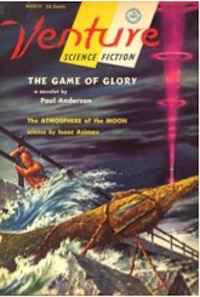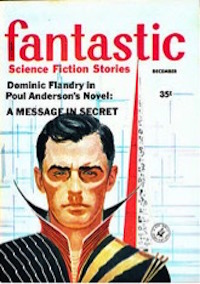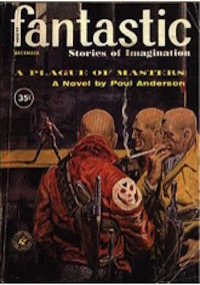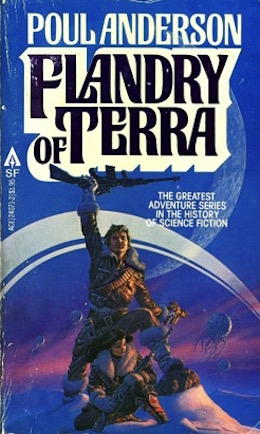In this monthly series reviewing classic science fiction books, Alan Brown will look at the front lines and frontiers of science fiction; books about soldiers and spacers, explorers and adventurers. Stories full of what Shakespeare used to refer to as “alarums and excursions”: battles, chases, clashes, and the stuff of excitement.
Sometimes a cover painting is all it takes to reel you in. The paperback copy of Flandry of Terra had a glorious cover by Michael Whelan that metaphorically jumped off the shelf of the bookstore and grabbed me by the scruff of the neck. While being a true and accurate depiction of characters from the story, the artwork also evoked some of Frank Frazetta’s best work: there was Flandry in a heroic pose, wearing cold weather gear and signaling to someone in the distance with his rifle, with a beautiful, similarly-clad woman crouching at his feet. A planetary ring arched in the background while airborne jellyfish floated above the wintry terrain. The author’s name was the icing on the cake: I was well acquainted with Poul Anderson’s work, and here was a whole new, exciting character—one who was completely unfamiliar to me. I had to buy this book, take it home, and see what I had been missing. And so it was, sometime in the early 1980s, that I first met Dominic Flandry. I was in for a treat.
In those days, it was impossible to be a science fiction fan and not have heard of Poul Anderson (1926-2001), then at the height of a career that, before it was over, would garner seven Hugos, three Nebulas, a SFWA Grand Master Award, and a host of other honors. Anderson was comfortable in a variety of sub-genres, having written epic fantasy, sword and sorcery, time travel, serious scientific extrapolation, adventure, and even humorous stories. My own knowledge of his work primarily involved tales that appeared in Astounding/Analog, stories of the Polesotechnic League, and master traders Nicholas van Rijn and David Falkayn. But with the introduction of Dominic Flandry, I found that Anderson’s future history (also referred to as the “Technic History”) spanned an even wider sweep of time. It not only described the growth of an interstellar human civilization, but in the tales of Flandry, showed the degeneration of that civilization into an empire on its way into oblivion. In charting the course of his future history, Anderson was obviously influenced by historians interested in long-term patterns of cultural growth and decline, evoking themes posited by those such as Gibbon, Toynbee, and Spengler.
 Many have remarked that with this character, Anderson had created a spacefaring version of James Bond, but when you compare publication dates, Flandry’s introduction actually predates Bond’s. In my opinion, though, the closest literary analog of Flandry is C. S. Forester’s Horatio Hornblower, the subject of a series of extremely popular books that followed an entire fictional career, the most famous of which were the original trilogy written in the late 1930s: Beat to Quarters, Ship of the Line, and Flying Colours. The popularity of the series initiated a modern sub-genre of historical fiction centered on the adventures of 18th and 19th century naval officers, paving the way for authors like Patrick O’Brian, James L. Nelson, and more recently Julian Stockwin. Dominic Flandry is not an exact match to Horatio Hornblower, of course—Hornblower was a warship commander, while Flandry an intelligence agent. But like Hornblower, Flandry’s first appearance was as a captain at the height of his powers (in the story “Tiger by the Tail,” which appeared in Planet Stories, January 1951). And like Forester, Anderson then went back and outlined the beginning of his hero’s career, and then continued the story into his later years. By the time he was done, Anderson had not only captured the grand sweep of history, but also the scope of an entire lifetime. He was not alone in inventing a Hornblower of the far future, however, with writers such as A. Bertram Chandler, David Weber, and Lois McMaster Bujold all ranking among the science fiction authors who have followed a similar template over a series of books.
Many have remarked that with this character, Anderson had created a spacefaring version of James Bond, but when you compare publication dates, Flandry’s introduction actually predates Bond’s. In my opinion, though, the closest literary analog of Flandry is C. S. Forester’s Horatio Hornblower, the subject of a series of extremely popular books that followed an entire fictional career, the most famous of which were the original trilogy written in the late 1930s: Beat to Quarters, Ship of the Line, and Flying Colours. The popularity of the series initiated a modern sub-genre of historical fiction centered on the adventures of 18th and 19th century naval officers, paving the way for authors like Patrick O’Brian, James L. Nelson, and more recently Julian Stockwin. Dominic Flandry is not an exact match to Horatio Hornblower, of course—Hornblower was a warship commander, while Flandry an intelligence agent. But like Hornblower, Flandry’s first appearance was as a captain at the height of his powers (in the story “Tiger by the Tail,” which appeared in Planet Stories, January 1951). And like Forester, Anderson then went back and outlined the beginning of his hero’s career, and then continued the story into his later years. By the time he was done, Anderson had not only captured the grand sweep of history, but also the scope of an entire lifetime. He was not alone in inventing a Hornblower of the far future, however, with writers such as A. Bertram Chandler, David Weber, and Lois McMaster Bujold all ranking among the science fiction authors who have followed a similar template over a series of books.
Dominic Flandry is a fascinating character, and a man of contradictions. He is vain and cocky, but for good reason, as he is keenly intelligent, clever, and physically capable. Flandry clawed his way from an obscure birth to the heights of imperial society, and climbed up the naval ranks from ensign to admiral, with a knighthood granted along the way. He is a hedonist who dresses like a peacock and loves nothing more than drinking and parties, but is devoted to his work in service to the Empire with a monkish intensity of purpose. He is a lover of women and attracts many in his travels, but his work does not allow him to remain with any of them for long, nor to put down any roots. He almost always prevails, but in the end is a tragic figure: no matter how successful he is, he knows the forces of history are inevitably tearing his precious empire apart.
 Anderson was a student of Norse mythology, and Flandry is like one of the heroes of the ancient sagas: noble, always striving, but in the end doomed to the fate that awaits all men. Underneath all the adventures and derring-do, Flandry’s life has a melancholy undertone that gives it weight and gravitas. I often wondered why Flandry never appeared in Analog like so many of Anderson’s other characters, but I suspect that the character and his romances were not to the taste of editor John Campbell, who seemed somewhat prudish in his avoidance of sex in the stories he published. Another reason might be the fact that many of the Flandry stories, while they have science fiction settings, do not always have plots that resolve around science and technology, but instead are often rooted more in politics and adventure.
Anderson was a student of Norse mythology, and Flandry is like one of the heroes of the ancient sagas: noble, always striving, but in the end doomed to the fate that awaits all men. Underneath all the adventures and derring-do, Flandry’s life has a melancholy undertone that gives it weight and gravitas. I often wondered why Flandry never appeared in Analog like so many of Anderson’s other characters, but I suspect that the character and his romances were not to the taste of editor John Campbell, who seemed somewhat prudish in his avoidance of sex in the stories he published. Another reason might be the fact that many of the Flandry stories, while they have science fiction settings, do not always have plots that resolve around science and technology, but instead are often rooted more in politics and adventure.
In choosing the book Flandry of Terra for this review, I admittedly used my heart and not my head. I could have started at the beginning of the series with Ensign Flandry. Or I could have picked the volume that brings the series to an emotional climax, A Knight of Ghosts and Shadows. But instead I picked the point where I first started reading the series, which in retrospect, was as good a place as any. Flandry of Terra is an omnibus, consisting of three novelettes. These tales find Captain Sir Dominic Flandry at the height of his powers, and each stands alone as a separate narrative that gives the reader a solid sense of its hero and the nature of his adventures.
The first tale, “The Game of Glory,” originally appeared in the March 1958 edition of Venture Science Fiction. The whispered confession of a dying soldier leads Flandry to the watery world of Nyanza in search of rebels. Nyanza is dominated by a people of African descent who are the shipmasters and traders, while a German minority of landlubbers maintain the world’s ports and industry. Flandry’s suspicions of trouble are confirmed when he finds the imperial ambassador recently murdered. He soon sails off with a beautiful and scantily clad shipmaster, Tessa, to the island that is home to the dead soldier’s family. Flandry, always eager to woo women even though he knows he must leave them behind, grows close to Tessa during their voyage. When he meets the father and brother of the dead soldier, John and Derek, he clashes with Derek, who has romantic interest in Tessa. Flandry finds himself the object of a murder attempt and discovers that there is indeed a plot afoot. An agent of the rival Merseian Empire has been arming a nearby island, which has triggered an arms race and unrest across the planet. When John is murdered, his grieving son Derek swallows his dislike to aid Flandry, who has to not only neutralize the rival island, but find and take out the enemy agent. Flandry plays, as he often does, the role of a spoiled and clueless imperial, but beneath it all he is lying, scheming, and manipulating everyone around him to achieve his goal of fending off the Long Night of imperial decline for at least a little longer.
 The second novelette, “A Message in Secret,” was reprinted from the December 1959 issue of Fantastic Science Fiction Stories. The story finds Flandry arriving on the planet Altai, a world well off the beaten track of normal commerce—a cold planet dominated by cold and snowy plains. He is a passenger on a Betelgeusean freighter (the only race that that is known to trade with Altai). The planet has been colonized by people from Central Asia, who have adopted a nomadic lifestyle similar to the one that their ancestors practiced on Earth. Around the planet’s single spaceport, Flandry observes weaponry that makes it obvious that the local Khan, Orleg, is in league with the Merseians. Though he quickly adopts his standard persona of a clueless, vapid imperial, he has seen too much and is soon imprisoned.
The second novelette, “A Message in Secret,” was reprinted from the December 1959 issue of Fantastic Science Fiction Stories. The story finds Flandry arriving on the planet Altai, a world well off the beaten track of normal commerce—a cold planet dominated by cold and snowy plains. He is a passenger on a Betelgeusean freighter (the only race that that is known to trade with Altai). The planet has been colonized by people from Central Asia, who have adopted a nomadic lifestyle similar to the one that their ancestors practiced on Earth. Around the planet’s single spaceport, Flandry observes weaponry that makes it obvious that the local Khan, Orleg, is in league with the Merseians. Though he quickly adopts his standard persona of a clueless, vapid imperial, he has seen too much and is soon imprisoned.
A beautiful woman, Bourtai, comes to visit him. She is daughter of a rival Khan who is also a prisoner of Orleg. Her visit forces Flandry into action, and they escape into the wilderness. After a brutal chase, they find Bourtai’s people. Although he has escaped, Flandry is in deep trouble. He desperately needs to get a message back to the empire, and with the spaceport under tight control, getting out himself is impossible. The solution to his problem involves the desecration of a temple, securing aid from a race of flying jellyfish creatures, and some incomprehensible military maneuvers. During these adventures we see that, beneath his vapid exterior, Flandry is a true warrior, as durable and tenacious as they come. And once again, a desirable woman must be left behind as he follows the call of duty.
The final novelette in the collection, “The Plague of Masters,” appeared in Fantastic Stories of Imagination in the December 1960 issue. This story is a bit deeper than the first two, and has a strong edge of social satire, showing the dangers of corruption and stagnation when government bureaucracy runs amok. It’s set on the planet of Unan Besar, which is on the warm and swampy side and is colonized by people from Malaysia. Flandry goes there to find out why this planet has stayed well off the beaten track, but instead of outside interference, he finds the world gripped by a totalitarian state. There is a deadly bacterial plague on Unan Besar that requires regular medication to keep it at bay. The Biocontrol organization, which regulates production of the medicine, has used their power to take control of the planet’s government. They also control the medicine that can cure the disease entirely—essential to anyone who wants to leave the planet alive. Warouw, the government agent who is assigned to Flandry, takes him to meet the planetary leaders, but they soon sees through his clueless tourist act and try to take him prisoner. Flandry escapes, and strikes out in search of some sort of illegal underground that can sell him the medicine he needs to stay alive.
 Fortunately, he finds his criminals in the form of a beautiful woman, Luang, and her hulking bodyguard, Kemul. Luang tells Flandry he must pull his own weight, and we see how Flandry, exiled with only the clothes on his back, manages to land on his feet, using his professional talents to lie and con his way into a great deal of money. They travel to a far away land and Luang tries to convince Flandry to stay with her and start a new life, but the pull of his duty is too strong, and Flandry never stops plotting to escape. Modern technology on other planets could easily and cheaply synthesize the medicine the people need, and he wants to free this planet from the grip of its Biocontrol overlords, then return home to his own life. Warouw, however, proves to be one of Flandry’s most tenacious opponents, and soon recaptures him. An act of kindness on Flandry’s part proves to be the key he needs to escape captivity again, and he devises a plan to leave the planet and return with all the medicine the people will need.
Fortunately, he finds his criminals in the form of a beautiful woman, Luang, and her hulking bodyguard, Kemul. Luang tells Flandry he must pull his own weight, and we see how Flandry, exiled with only the clothes on his back, manages to land on his feet, using his professional talents to lie and con his way into a great deal of money. They travel to a far away land and Luang tries to convince Flandry to stay with her and start a new life, but the pull of his duty is too strong, and Flandry never stops plotting to escape. Modern technology on other planets could easily and cheaply synthesize the medicine the people need, and he wants to free this planet from the grip of its Biocontrol overlords, then return home to his own life. Warouw, however, proves to be one of Flandry’s most tenacious opponents, and soon recaptures him. An act of kindness on Flandry’s part proves to be the key he needs to escape captivity again, and he devises a plan to leave the planet and return with all the medicine the people will need.
These three stories showcase the talents of Poul Anderson at his best. The planets and interstellar worlds are designed with great care and scientific consistency, and the alien species and ecologies are convincing. Anderson also conceived his societies with great attention to history and sociology. It was admittedly a bit jarring to encounter so much smoking going on—a casual habit that has almost disappeared from literature and film in recent years—and the gender roles seem a bit archaic to the modern viewpoint. While it might not seem so at first, however, the women Flandry meets are strong characters in their own right: Tessa is a government official, Bourtai fights right alongside the men of her tribe, and Luang is a clever and accomplished criminal outsmarting an oppressive regime. Flandry sometimes behaves like a cad, prejudiced and sexist in a way that jars modern sensibilities; but with all his flaws, he remains a compelling character whose adventures make for exciting reading.
I was saddened to visit a large bookstore recently and find not a single book by Poul Anderson on the shelves. These days, books seem to disappear from the shelves so quickly that it can cause people to miss out on older works that are well worth reading. Whether you search on the internet, the library, or in a used bookstore, Poul Anderson’s tales of Dominic Flandry are well worth seeking out. You will not be disappointed.
Alan Brown has been a science fiction fan for five decades, especially science fiction that deals with military matters, exploration and adventure. He is also a retired reserve officer with a background in military history and strategy.










